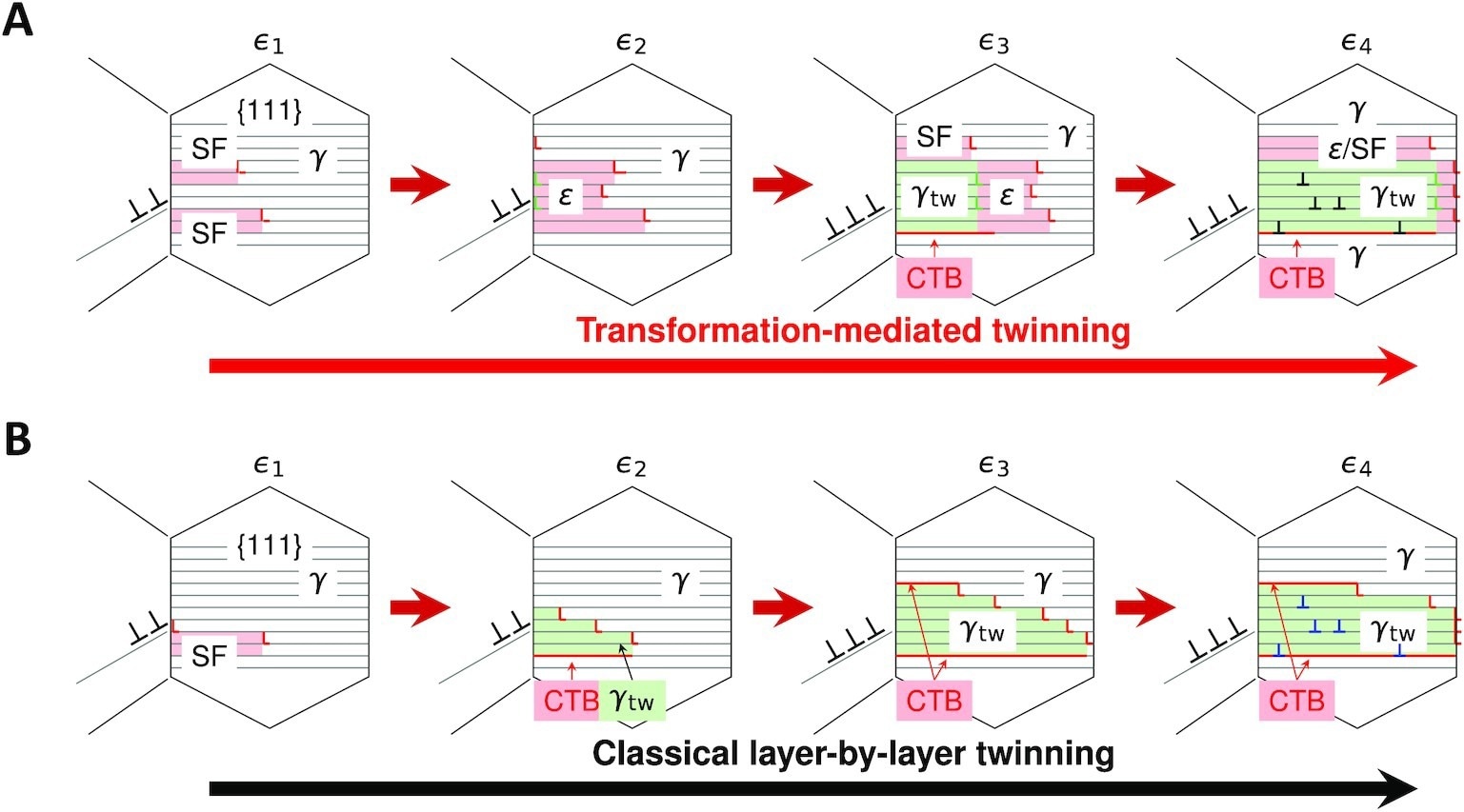Research has shown that face-centered cubic (fcc) composites with high-density and nanoscale deformation twins can greatly improve the balance of ductility and strength. Still, the microscopic dislocation processes that enable great twinnability are unknown.

Schematics of deformation structure evolution with increasing strain levels (ϵ1 to ϵ4) via different twinning mechanisms with partials nucleated from grain boundaries. (A) Transformation-mediated twinning, showing the γ → SF/ε → γtw two-step twinning process, the formation of the characteristic γ/ε/γ and γ/γtw/ε/γ deformation lamellar structures. (B) Classical layer-by-layer twinning in thermodynamically stable fcc materials with positive SFE. Lu, S. et al. (2022).
A recent study in the journal PNAS Nexus discovered transformation-mediated twinning (TMT), a novel twinning process present in metastable fcc substances. A displacive change from the fcc phase to the hexagonal close-packed (hcp) phase precedes this process, accompanied by a subsequent transition from the hcp phase to the fcc twin.
Deformation Mechanisms for Metallic Materials
Plastic deformation of metallic materials is primarily controlled by the nucleation and movement of dislocations. However, strengthening metals via conventional methods of creating internal barriers for dislocation motion compromises strength and ductility.
To overcome this, additional deformation mechanisms such as strain-stimulated phase transformation or twinning can be employed. These approaches have produced alloys with high strength and exceptional ductility due to twinning-induced plasticity (TWIP) and transformation-induced plasticity (TRIP).
Deformation twinning (DT) is a face-centered cubic (fcc) material deformation process. It entails the deposition and gliding of Shockley partial misalignments on successive close-packed planes, leading to a progressive inversion of the close-packed plane stacking order from fcc (ABCABC) to twin (CBACBA).
Another method, deformation-induced martensite transformation (DIMT), involves regular partial movements on every other close-packed plane, leading to the transformation of fcc to a hexagonal close-packed (hcp) structure (γ → ε).
This transformation occurs similarly to DT, involving nucleation on a stacking fault (SF) plane, the formation of a four-layer ε nucleus, and ε thickening.
Challenges in Understanding Concurrent Deformation Mechanisms
Conventional plasticity concepts and methods regard the deformation processes of DIMT and DT as mutually exclusive, occurring in metals with distinct bands of stacking fault energies (SFEs) due to to chemical differences.
Nonetheless, DIMT and DT have been seen in similar grains in several metallic systems, generating a unique alternative lamellar structure composed of nano-thickened fcc twin (tw) and hcp laths.
This nanosized deformation pattern is critical because it contains considerable plasticity and interacts extensively with dislocations, triggering improved work-hardening capability.
Yet, the coexistence of DIMT and DT calls into question the current understanding of the underlying microscopic process, which remains unclear even after over a half-century of observation.
This incomplete knowledge of the deformation kinetics in these alloys and metals has hindered the capacity to reliably forecast composition-structure-property correlations, limiting the ability to develop materials with better mechanical characteristics.
Novel Transformation-Mediated Twinning Mechanism in Metastable Alloys
In this study, the authors set out to investigate the atomistic mechanisms that cause the deformation mode transition from γ → ε DIMT to DT in thermodynamically unstable (metastable) fcc alloys and metals.
To achieve this, the authors used quantum mechanical density functional theory (DFT) calculations to identify a twinning mechanism that does not follow the classical γ → γ twin layer-by-layer twinning (cTW) path.
Instead, the authors proposed a novel transformation-mediated twinning (TMT) mechanism to explain the pronounced twinning activities observed in metastable alloys.
To understand the TMT mechanism, the authors used DFT simulations to demonstrate that DT may be accomplished through an intermediate γ → ε DIMT by successively activating clusters of partial dislocations, resulting in a two-step γ → ε → γ twin twinning process.
Important Findings
The study has revealed that the two-step transformation process (γ → ε → γ tw) is a critical mechanism underlying the exceptional twinnability and formation of nano lamella deformation structures in metastable fcc alloys.
While the reverse ε → γ transformation in hcp metals has been observed, the two-step transformation has not been considered a crucial mechanism due to limitations in experiments in determining the true SFE in metastable materials.
However, the present study has used quantum-mechanical DFT calculations to access critical material parameters that control the two-step phase transformation processes with high resolution, enabling the establishment of the composition-SFE-deformation mechanism relationship.
These findings provide a solid physics-based and universal understanding of the plasticity theory in metastable fcc materials and guide the design of advanced high-strength materials to overcome the strength-ductility trade-off in the infinite composition space.
Future research can further explore the applicability of the two-step transformation mechanism to other metastable fcc alloys, and validate the findings experimentally to support the development of innovative materials with superior mechanical properties.
Study co-author Song Lu comments on the findings, "Improved mechanical properties of structural materials enable reduced weight and need for raw materials and can thus contribute to the energy saving goals that are needed for a more sustainable society.”
Reference
Lu, S. et al. (2022). Theory of transformation-mediated twinning. PNAS Nexus. Available at: https://doi.org/10.1093/pnasnexus/pgac282
Disclaimer: The views expressed here are those of the author expressed in their private capacity and do not necessarily represent the views of AZoM.com Limited T/A AZoNetwork the owner and operator of this website. This disclaimer forms part of the Terms and conditions of use of this website.